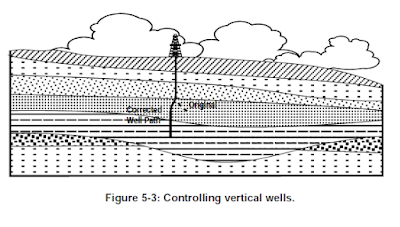Nudging
The technique of “nudging” is used on platforms in order to “spread out”
conductors and surface casings, which minimizes the chance of a collision.
Basically, when the hole for surface casing is drilled, some angle is built at
a low rate (e.g. 1°/100') in the chosen direction.
In addition to “spreading things out”, other reasons for “nudging” are:
• to drill from a slot located on the opposite side of the platform from
the target, when there are other wells in between
• to keep wells drilled in the same general direction as far apart as
possible
• if the required horizontal displacement of a well is large compared to
the total vertical depth, then it is necessary to build angle right below
the surface conductor to avoid having to use a high build rate
The technique of “nudging” is used on platforms in order to “spread out”
conductors and surface casings, which minimizes the chance of a collision.
Basically, when the hole for surface casing is drilled, some angle is built at
a low rate (e.g. 1°/100') in the chosen direction.
In addition to “spreading things out”, other reasons for “nudging” are:
• to drill from a slot located on the opposite side of the platform from
the target, when there are other wells in between
• to keep wells drilled in the same general direction as far apart as
possible
• if the required horizontal displacement of a well is large compared to
the total vertical depth, then it is necessary to build angle right below
the surface conductor to avoid having to use a high build rate














